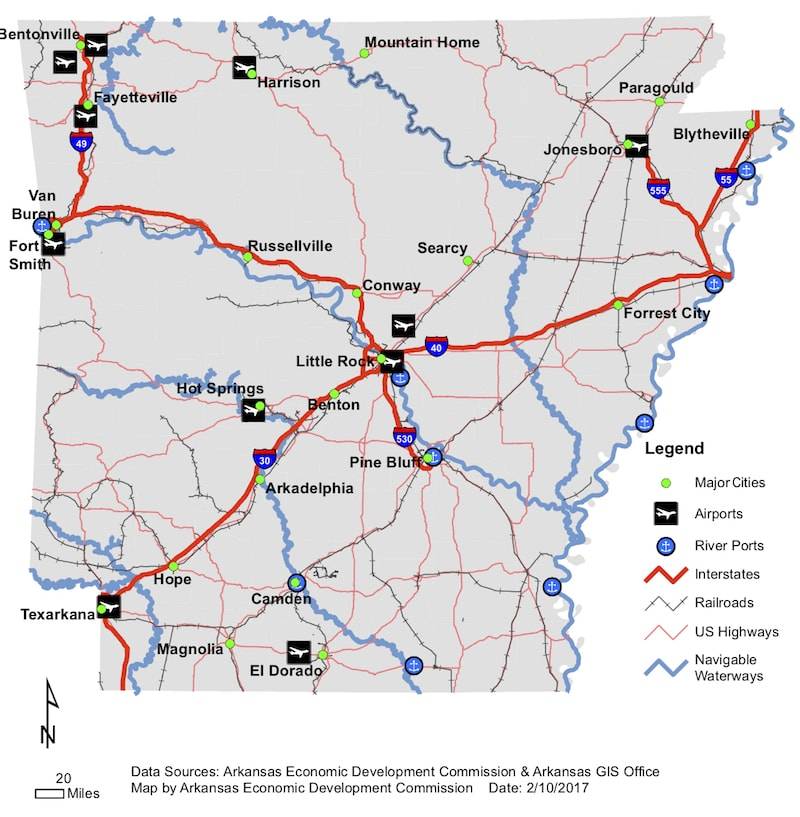All Roads Lead to Arkansas: Central Location and Modern Infrastructure Help Draw Business Development
January 12, 2018Infrastructure is an essential component to the state’s economic development. The ability to move materials and goods quickly and easily within and outside the state is a key consideration for businesses looking to expand or relocate within Arkansas. Governor Asa Hutchinson has prioritized investing in infrastructure during his administration, stating, “…it is imperative that the state maintain a first-rate transportation infrastructure system as part of our pro-business environment. Our tourism sector, which means more than $7 billion annually to our economy, also relies heavily on our existing infrastructure.”
Centered between Canada and Mexico, and located in the middle of the United States, Arkansas is strategically situated to reach tens of millions of people easily and cost efficiently. Arkansas offers businesses easy access to a market of 100 million people within a 550-mile radius of the state. That represents more than 40 percent of the total U.S. population.
Open Map PDF
Trucking & Distribution
Arkansas is home to more than 80 distribution centers and 10 major trucking companies, with more than 52,000 people employed in distribution centers and trucking firms in the state. With its central location and comprehensive transportation infrastructure, it's not surprising that Arkansas has a large and growing distribution and logistics services sector. In fact, the state is home to two transportation/trucking companies on Fortune magazine's list of the largest 1,000 companies in the United States, based on annual revenue–J.B. Hunt Transport Services and ArcBest.
Five of the 25 largest employers in Arkansas are in the transportation services sector, including J.B. Hunt, USA Truck, FedEx Corporation and Union Pacific Railroad. The state's comprehensive transportation system can easily move bulk commodities and consumer goods. Many of Arkansas’ port locations have railway connections that provide a smooth transition for various modes of transportation and quick delivery.
Interstates
Located midway between Mexico City and Montreal, Arkansas has the nation's 12th largest network of highways. Interstate 40, a major east-west thoroughfare reaching from North Carolina to California, runs through the heart of Arkansas. Interstate 55 links eastern Arkansas to St. Louis and Chicago to the north and New Orleans to the south. Interstate 30 connects Arkansas with markets to the southwest, including Texas and Mexico.
Download Arkansas’ Interstates Infrastructure Map
Air Service
Arkansas’ airports are conveniently located minutes from the state’s major downtowns. The Bill and Hillary Clinton National Airport (LIT), Arkansas’ largest commercial service airport, serves approximately 2 million passengers annually. With more than 70 departures each day, and non-stop jet service to 13 national gateway cities, Little Rock is truly one stop away from the world.
In addition to commercial aircraft, Clinton National serves general aviation/private aircraft with two fixed base operators on the field: TAC Air and Fly Arkansas, LLC.
The Northwest Arkansas Regional Aiport (XNA), which opened in 1998, is the state's second largest travel hub, serving non-stop flights to several national airports. Regional airports in El Dorado, Fort Smith, Harrison, Hot Springs, Jonesboro and Texarkana also provide commercial service to several national airports. These airports provide both day and night services, and most have instrument approach capability.
The Arkansas Aeroplex at Blytheville, formerly Eaker Air Force Base, is the state's second largest industrial complex and one of the largest commercial airstrips in the central United States. Situated in a campus-like setting, the facility offers fiber-optic technology, 1.5 million square feet of available facilities and space for new construction.
Download Arkansas’ Airport Infrastructure Map
Waterways
More than 1,000 miles of navigable waterways link Arkansas with ports worldwide. There is a navigable river within 65 miles of every county in the state. Arkansas’ rivers remain ice-free throughout the year, allowing continuous movement of goods. Steel, fertilizers, petroleum products, grains and many other goods travel through the many public ports, private terminals and riverfront industrial sites.
Three ports are located along the Arkansas River as it flows past the population/manufacturing centers of Little Rock, Pine Bluff and Fort Smith. Mississippi River terminals are located in Osceola, West Memphis, McGehee and Helena/West Helena.
Download Arkansas' Waterways Infrastructure Map
Rail Service
Arkansas has more than 2,400 miles of track and is home to three Class I rail systems: Union Pacific, BNSF Railway and Kansas City Southern Railway. Union Pacific Railroad operates major yards in North Little Rock and Pine Bluff, along with a locomotive overhaul and maintenance facility in North Little Rock. It is the largest and most modern such facility within the Union Pacific System.
Download Arkansas' Railway Infrastructure Map
Intermodal Facilities
Arkansas’ intermodal transportation network of highways, railways, air routes, waterways and pipelines is ideally suited to meet the needs of business. These facilities provide easy access to U.S. markets as well as world markets.
Intermodal freight facilities in Arkansas include the river ports at Little Rock, Pine Bluff and Van Buren. Regional intermodal freight facilities authorities in Arkansas include Blytheville-Mississippi County Regional Intermodal Authority, Northeast Arkansas Regional Intermodal Authority, River Valley Intermodal Facilities Authority, Regional Intermodal Transportation Authority of Western Arkansas, Southwest Arkansas Regional Intermodal Authority, Southeast Arkansas Regional Intermodal Facility and Western Arkansas Regional Intermodal Port Authority.
Union Pacific Railroad has a $70 million state-of-the-art intermodal facility on 600 acres in Marion, just north of where Interstates 40 and 55 converge. Nearby is the Burlington Northern Santa Fe’s Harvard Yard, plus close access to three other rail carriers.
The Marion site is across the Mississippi River — the nation’s most traveled river — from Memphis, with its international airport and FedEx Superhub.
Pipeline/refinery/fuel storage complexes are located throughout the state. Some include the Delek Oil refinery/fuel storage complex in El Dorado, the Valero Partners Operating Co. in West Memphis and the Central Point Terminal in North Little Rock.



